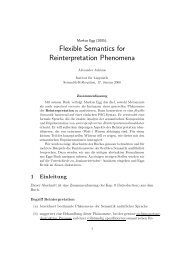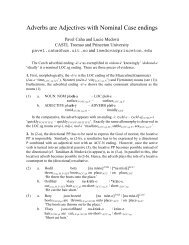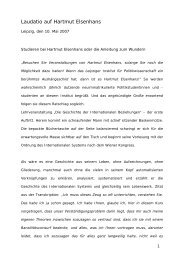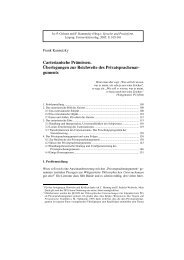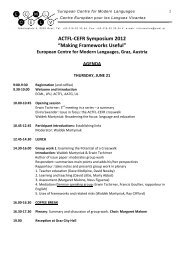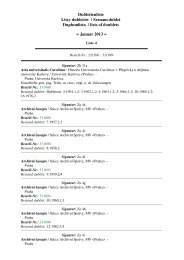2011 ACTFL CEFR Conference Report
2011 ACTFL CEFR Conference Report
2011 ACTFL CEFR Conference Report
Create successful ePaper yourself
Turn your PDF publications into a flip-book with our unique Google optimized e-Paper software.
<strong>2011</strong> <strong>ACTFL</strong> <strong>CEFR</strong><br />
<strong>Conference</strong> <strong>Report</strong><br />
The Elements of Proficiency:<br />
An Emerging Consensus for Language Assessment and<br />
Instruction
Overview:<br />
The <strong>2011</strong> <strong>ACTFL</strong> <strong>CEFR</strong> <strong>Conference</strong> was held on August 4-6, <strong>2011</strong> at the Marriott Hotel and<br />
<strong>Conference</strong> Center in Provo, Utah. The title and theme of the conference was: “The Elements of<br />
Proficiency: An Emerging Consensus for Language Assessment and Instruction.” The <strong>2011</strong><br />
<strong>Conference</strong> was the 2nd annual conference of this type, bringing together language experts from<br />
the United States and Europe to explore and discuss common understandings about language<br />
proficiency. This year’s meeting continued the work of the 2010 <strong>ACTFL</strong> <strong>CEFR</strong> Alignment<br />
<strong>Conference</strong> held in Leipzig, Germany which explored correspondences between the <strong>ACTFL</strong><br />
Proficiency Guidelines and the Common European Framework of Reference for Languages<br />
(<strong>CEFR</strong>) on theoretical and empirical grounds.<br />
The goals for the <strong>2011</strong> <strong>Conference</strong> were to help practitioners all over the world to understand the<br />
essential elements of proficiency and how it is assessed, to better understand both the <strong>ACTFL</strong><br />
and <strong>CEFR</strong> systems and how they relate to proficiency and its assessment, and to understand their<br />
implications for teaching and learning, curriculum and materials development, and thereby to<br />
improve both systems and their assessment instruments.<br />
Sponsors of the <strong>2011</strong> <strong>Conference</strong> were the American Council on the Teaching of Foreign<br />
Languages (<strong>ACTFL</strong>), Brigham Young University (BYU), and the American Association of<br />
Teachers of German (AATG). The <strong>Conference</strong> organizers were Elvira Swender, Director of<br />
<strong>ACTFL</strong> Professional Programs, Erwin Tschirner, Professor, University of Leipzig, Ray Clifford,<br />
Associate Dean of Humanities, Brigham Young University, and Helene Zimmer-Loew,<br />
Executive Director of AATG.<br />
The <strong>Conference</strong> was attended by 43 people representing organizations from seven countries. In<br />
addition to the Council of Europe, which sent two official representatives to the <strong>Conference</strong>, the<br />
following professional associations, academic institutions, cultural organizations, and<br />
government agencies were represented:<br />
AATG<br />
<strong>ACTFL</strong><br />
Ballard & Tighe, Publishers<br />
Brigham Young University<br />
Cambridge Michigan Language<br />
Assessments<br />
Center for Applied Linguistics<br />
Centre for Applied Language Studies<br />
University of Jyväskylä<br />
European Centre for Modern Languages<br />
Defense Language Institute<br />
U.S. Department of Education<br />
Generalitat de Catalunya<br />
Federal Bureau of Investigation<br />
Goethe-Institut-New York<br />
Indiana University of Pennsylvania;<br />
Instituto Cervantes – Chicago<br />
Iowa State University<br />
Kentucky Department of Education;<br />
Lidget Green, Inc.<br />
LTI: The <strong>ACTFL</strong> Testing Office<br />
National Language Service Corps<br />
North Carolina Department of Public<br />
Instruction
Northern Kentucky University<br />
Second Language Testing, Inc.<br />
SWA Consulting, Inc.<br />
Teachers College, Columbia University<br />
TELC<br />
Trinity College, Dublin<br />
Opening Remarks and Keynote Presentations:<br />
University of Gothenburg<br />
University of Iowa; University of Leipzig<br />
University of Nebraska-Lincoln<br />
U.S. Department of Defense<br />
Utah State Office of Education<br />
University College, Utrecht<br />
The conference began with welcoming remarks from John Rosenberg, Dean of the College of<br />
Humanities at Brigham Young University, Eileen Glisan, <strong>ACTFL</strong> Past President, and Carol<br />
Anne Costabile-Heming, President of AATG. John Trim, University of Cambridge, delivered an<br />
address via video conference from Cambridge, in which he reminded the audience of the critical<br />
importance of a US - European collaboration on the issues and challenges of language<br />
proficiency. The entire text of John Trim’s address can be found at the end of this report. Two<br />
Keynote presentations were delivered. The first keynote, “Language Proficiency <strong>2011</strong>, was<br />
delivered by Carol Chapelle of Iowa State University. David Little of Trinity College, Dublin<br />
(Ireland) gave the second keynote presentation, “Elements of L2 Proficiency: The <strong>CEFR</strong>’s<br />
Action-Oriented Approach and its Implications.” Abstracts for the keynote addresses as well as<br />
for all the presentations can also be found at the end of this report.<br />
Presentations:<br />
The conference presentations were divided into three main topic areas: 1) The Elements of<br />
Proficiency, 2) Current U.S. and European Initiatives, and 3) Implications. Topic 1 (Elements of<br />
Proficiency) presenters were: James Purpura, Columbia University, Ari Huhta, University of<br />
Jyväskylä (Finland), and Erwin Tschirner University of Leipzig (Germany). Topic 2 (Current US<br />
and European Initiatives) presenters were Eileen Glisan, Indiana University of Pennsylvania,<br />
Elvira Swender, <strong>ACTFL</strong>, and Jacque van Houten Kentucky Department of Education. Topic 3<br />
(Implications) presenters were Sari Luoma, Ballard and Tighe Publishers, and Ray Clifford,<br />
Brigham Young University.<br />
Breakout Sessions:<br />
In addition to the presentations, the conference featured two breakout sessions. The first breakout<br />
session occurred on the first afternoon of the conference. Participants were divided into four<br />
groups (representing the four language skills – speaking, listening, reading, and writing). The<br />
tasks for this breakout session were to review and discuss the essential elements of proficiency
for the group’s skill (reading, speaking, listening, or writing) as mentioned in the topic 1 papers<br />
presented and to determine if these elements are adequately referenced in the <strong>ACTFL</strong> Guidelines<br />
and the <strong>CEFR</strong> documents. Participants were asked to note whether the reference to the essential<br />
element was adequate, incomplete, needed elaboration, or was missing. Group members were<br />
asked to suggest revisions when appropriate. Following this breakout session, a representative<br />
from each group presented the group’s findings in a general session, which was followed by a<br />
discussion period.<br />
The second breakout session was a benchmarking activity during which participants were<br />
divided into the same skill-specific groups in which they had worked during the first breakout<br />
session. For this activity, participants were asked to rate a variety of samples taken from both<br />
<strong>ACTFL</strong> and <strong>CEFR</strong> assessments and to assign an <strong>ACTFL</strong> and a <strong>CEFR</strong> rating based on the<br />
reference documents provided. Ratings for each of the skill groups were collected and are<br />
currently being analyzed for correspondences.<br />
Plenary Discussion: Prioritizing Initiatives<br />
An open discussion on the second day of the conference generated many ideas and suggestions<br />
for future <strong>ACTFL</strong> <strong>CEFR</strong> collaborative initiatives. The participants were then asked to indicate<br />
their top 3-4 priorities. By an overwhelming vote, the desire to continue to explore the <strong>ACTFL</strong><br />
<strong>CEFR</strong> crosswalk was selected as the top priority, reaffirming this need not only for assessment<br />
purposes but also for teaching, learning and policy reasons. Other priorities indicated were: to<br />
develop a glossary of terms that are used in both scales, to secure funding to conduct long term<br />
joint studies to investigate realistic student outcomes from different program models<br />
(US/Europe/Canada), and to explore formative assessment initiatives that focus on<br />
commonalities for all language learners. Additional cooperation initiatives mentioned included<br />
the following: the intersections of the <strong>ACTFL</strong> K-12 Performance Guidelines and the <strong>CEFR</strong>, the<br />
sharing of models of best practices, the testing of receptive skills, the extent to which the two<br />
frameworks can be used to provide diagnostic information about language learners, and a study<br />
of “can-do” statements.<br />
Discussions were initiated regarding concrete steps forward that might be accomplished prior to<br />
a next meeting. Specific initiatives included side-by-studies of Instituto Cervantes and <strong>ACTFL</strong><br />
Writing and Speaking tests, and Goethe-Institut and <strong>ACTFL</strong> assessments.
Panel Discussion: Implications for Language Policy, Assessment, and Curriculum and<br />
Instruction<br />
During the final panel, panel members Pardee Lowe (US Department of Defense), Neus Figueras<br />
Casanovas (Catalunia Department of Education), David Little (Trinity College, Dublin), Meg<br />
Malone (Center for Applied Linguistics), Olaf Bärenfänger (University of Leipzig), and Thomas<br />
Parry (Defense Language Institute) spoke of the challenges and opportunities of creating a<br />
common space for the teaching and learning of languages. Recognizing how similar the<br />
challenges are on both sides of the Atlantic and that a number of initiatives exist that the other<br />
may not be aware of, there was a clear expression of the need and desire to establish a system for<br />
sharing resources and major accomplishments of both groups.<br />
Concluding Remarks<br />
This meeting was a resounding success! Concrete plans have already been put in place to<br />
maintain the momentum and continue the collaborative effort. A 2012 <strong>ACTFL</strong> <strong>CEFR</strong> Meeting is<br />
being organized for next summer; the planning committee will be meeting at the <strong>ACTFL</strong><br />
Convention in Denver to develop objectives, agenda items, and discussion topics. The<br />
University of Leipzig has offered to once again host this meeting with continued support from<br />
<strong>ACTFL</strong> and AATG. Organizers of this year’s meeting are confident that the Council of Europe<br />
will choose to be an official sponsor of a 2012 <strong>Conference</strong>, and they will soon be approaching<br />
the Council of Europe, as well other interested organizations and institutions, to seek support.<br />
As an outcome of this year’s meeting, original research is already underway and will be reported<br />
at next year’s meeting. In addition, the papers presented this year will be reviewed and published<br />
next year.
Presentation Abstracts:<br />
“Language Proficiency <strong>2011</strong>”<br />
Carol A. Chapelle<br />
Over the past fifty years of language testing, language proficiency has been variously defined as consisting of a<br />
number of interrelated components such as grammatical competence and pragmatic competence. Despite the<br />
different histories and contexts of frameworks such as the <strong>ACTFL</strong> and the <strong>CEFR</strong>, they include reference to some<br />
common elements in scale descriptors. However, elements of proficiency named in scale descriptors also differ<br />
across scales intended to measure second language proficiency, and therefore projects comparing scales have to<br />
grasp the reasons for differences across scales. This paper will outline salient points of consensus evident in scale<br />
descriptors based on the two frameworks. It will also discuss why the elements of proficiency can differ across<br />
language scales depending on their intended purposes.<br />
“Elements of L2 proficiency: the <strong>CEFR</strong>’s action-oriented approach and its implications”<br />
David Little<br />
The <strong>CEFR</strong> “views users and learners of a language primarily as ‘social agents’, i.e. members of society who have<br />
tasks (not exclusively language-related) to accomplish in a given set of circumstances, in a specific environment and<br />
within a particular field of action” (Council of Europe 2001: 9). This action-oriented approach, with its emphasis on<br />
the agency of the individual L2 user/learner, is designed to help “educational administrators, course designers,<br />
teachers, teacher trainers, examining bodies, etc., to reflect on their current practice with a view to situating and coordinating<br />
their efforts and to ensuring that they meet the real needs of the learners to whom they are responsible’<br />
(ibid.: 1; emphasis added). The <strong>CEFR</strong> continues the Council of Europe’s effort to “make the process of language<br />
learning more democratic by providing the conceptual tools for the planning, construction and conduct of courses<br />
closely geared to the needs, motivations and characteristics of the learner and enabling him so far as possible to steer<br />
and control his own progress” (Trim 1978: 1; emphasis added). This presentation will summarize the elements of<br />
L2 proficiency identified by the <strong>CEFR</strong>’s action-oriented approach and consider the variety of possible learning<br />
trajectories implicit in the common reference levels. It will then explore some of the <strong>CEFR</strong>’s implications for<br />
language education policy, curriculum, pedagogy and assessment, and will conclude by suggesting a possible<br />
agenda for future action.<br />
References: Council of Europe, 2001: Common European Framework of Reference for Languages: Learning,<br />
teaching, assessment. Cambridge: Cambridge University Press; Trim, J.L.M., 1978: Some possible lines of<br />
development of an overall structure for a European unit/credit scheme for foreign language learning by adults.<br />
Strasbourg: Council of Europe.<br />
“A comparative analysis of the fundamental resources of communicative effectiveness in the <strong>ACTFL</strong>/ILR and<br />
<strong>CEFR</strong> frameworks”<br />
James Purpura<br />
Communicative effectiveness, or the ability to accomplish communicative tasks efficiently, depends to a large extent<br />
on a learner’s grammatical knowledge & how this knowledge is used to understand or produce a range of literal &<br />
pragmatic meanings in socially and culturally-rich language use contexts (Purpura, 2004).The measurement of<br />
communicative effectiveness across different proficiency levels is contingent upon a coherent system for measuring<br />
the fundamental elements of communication, so that raters have a basis for assigning scores, and equally important,<br />
so that teachers and learners have a basis for closing learning gaps. In this paper, I will examine the fundamental<br />
resources of communicative effectiveness underlying both the <strong>ACTFL</strong>/IRL and the <strong>CEFR</strong> frameworks as they are<br />
used to describe functional competency at different proficiency levels. I will then compare these resources across<br />
frameworks. Finally, I will discuss some of the research that has investigated the nature of language ability across<br />
the different proficiency levels for each of the frameworks.
“DIALUKI – Diagnosing reading and writing in a second or foreign language”<br />
Ari Huhta<br />
The presentation reports on the findings from Stage 1 of the research project DIALUKI – Diagnosing reading and<br />
writing in a second or foreign language, which is an international four-year study (2010-2013) into the diagnosis of<br />
reading and writing abilities in L2 (see www.jyu.fi/dialuki). It seeks to identify the cognitive, affective and linguistic<br />
features which predict a learner's strengths and weaknesses in those areas. The project brings together scholars from<br />
applied linguistics, psychology and assessment to engage in multidisciplinary work and to develop innovative ways<br />
of diagnosing the development of L2 abilities. The project will deepen our understanding of L2 development and of<br />
factors that affect it, and will formulate a range of well-grounded hypotheses for further work on L2 diagnosis.<br />
In Stage 1 of the project, several hundred learners (aged 10-18) of English as a foreign language and<br />
Finnish as a second language were studied cross-sectionally in Finland. The study explored the diagnostic potential<br />
of a range of cognitive and psycholinguistic measures (e.g., working memory, phonological processing, ability to<br />
process non-words), of lexical and motivation measures by examining their relationship to measures of first and<br />
second / foreign language reading and writing abilities (e.g. PISA tests of reading in the language of instruction, the<br />
Pearson Test of English General and DIALANG tests).<br />
The presentation will focus on what our analyses have revealed so far about the ability of a range of<br />
linguistic, cognitive and motivational and background characteristics to predict reading in English as a foreign<br />
language. An attempt will also be made to provide a preliminary characterization of the <strong>CEFR</strong> levels A1 – B2 / C1<br />
in reading English as FL in terms of certain linguistic (e.g. vocabulary) and cognitive features measured in the study.<br />
“Orality vs. literarity: Capturing differences between colloquial and educated speech”<br />
Erwin Tschirner<br />
Oral text types pose differing cognitive demands that may be framed developmentally: demands on automaticity<br />
(grammar; collocations); demands on language knowledge (routines; words); and demands on functional knowledge<br />
(speech acts; register; sociolinguistic awareness). Both frameworks, <strong>ACTFL</strong>/ILR and <strong>CEFR</strong>, work with the notion<br />
of educated native speaker. In this paper, I will argue that this view of developmental hierarchies is compatible with<br />
the notions of conceptual orality and literarity (Koch &Oesterreicher 1985). If we are to assume that there is indeed<br />
a developmental perspective implied in the continuum from conceptual orality to literarity, then these concepts may<br />
be useful in determining what the salient and representative features of various developmentally hierarchized oral<br />
text types may be, what kind of descriptors may capture them and what kind of test procedures may make sure that<br />
they are elicited reliably and validly.<br />
“<strong>ACTFL</strong>'s Research Priorities Project: Phase I Preliminary Results”<br />
Eileen Glisan<br />
This paper will present preliminary results of <strong>ACTFL</strong>'s new Research Priorities initiative, designed to promote<br />
investigation in key areas in which research is needed to inform and improve classroom practice in foreign language<br />
education. Results will focus on three of the nine priority areas studied in Phase I: 1) relationship between teachers'<br />
oral proficiency levels and teaching effectiveness, 2) integration of content and development of proficiency, and 3)<br />
high leverage teaching practices. Information will be shared regarding the research to be conducted in Phase II of the<br />
project.<br />
“Revising the <strong>ACTFL</strong> Proficiency Guidelines: Questions and Challenges”<br />
Elvira Swender<br />
The <strong>ACTFL</strong> Proficiency Guidelines, first published in 1982, are currently undergoing revision. The Guidelines for<br />
Speaking were first revised in 1999 and the Guidelines for Writing were first revised in 2001. This will be the first<br />
major revision for the Reading and Listening Guidelines. This presentation will provide a brief overview of the<br />
current status of the revision initiative and highlight some of the questions and challenges faced by the revision<br />
committee in order to capture both empirical and experiential findings about language proficiency.
“The Role of World Languages in States’ Accountability Systems”<br />
Jaqueline Van Houten<br />
For the past ten years No Child Left Behind (NCLB) has served as a system for states to report yearly annual<br />
progress in core subject areas. World languages, while referred to as one of the core subjects, was neither federally<br />
funded nor systemically assessed at the state level. With the change in administration, the reauthorization of the<br />
Elementary and Secondary Education Act (ESEA) on the horizon, and the Obama Education Blueprint setting<br />
priorities, Secretary of Education, Arne Duncan has announced that if Congress cannot come to bipartisan terms to<br />
reshape NCLB by fall, he will “unleash energy for reform at the local level.” The Chief State School Officers<br />
Organization (CCSSO), collaborating with the National Governors Association (NGA) to lead educational reform,<br />
suggests new growth models for school accountability. Many states are proactively working alone or in consortia to<br />
develop such models. This paper will examine how world languages fit into the model and how states experimenting<br />
with granting credit for proficiency are using world languages as a testing ground.<br />
“The <strong>CEFR</strong> in Assessment and Instruction: Initiatives and Developments”<br />
Neus Figueras Casanovas<br />
The Common European Framework of Reference for Languages: Learning, Teaching, Assessment, a document<br />
published only ten years ago (2001) has had a tremendous impact in the field of language instruction and assessment<br />
across Europe and beyond. In this session, current developments in relation to the <strong>CEFR</strong> will be explored with<br />
reference to the work and principles of the Council of Europe and its Language Policy Division, founded in 1949<br />
and 1957 respectively. <strong>CEFR</strong>-related initiatives can be grouped into three main areas, the most relevant to the<br />
<strong>ACTFL</strong>-<strong>CEFR</strong> <strong>Conference</strong> being the toolkit to develop and relate examinations to the <strong>CEFR</strong>, plus two otherequally<br />
salient ones, those involving Language Policies and policy Recommendations and Resolutions, and those focusing<br />
on networking and dissemination.<br />
“Implications of a Possible <strong>ACTFL</strong>/ILR-<strong>CEFR</strong> Crosswalk for Assessment”<br />
Sari Luoma<br />
In this presentation, "crosswalk" is defined as a comprehensive exercise that establishes the nature of the<br />
relationship between two systems. It is argued that while a key purpose of crosswalks is to identify correspondences,<br />
an equally important counterpart is to establish the nature of the differences - in terms of purpose, scope, emphasis,<br />
application, and interpretation. The results of both types of evaluation drive the implications from the <strong>ACTFL</strong>/ILR-<br />
<strong>CEFR</strong> crosswalk for assessment. This definition broadens the results of a crosswalking exercise from a simple table<br />
of level correspondences to a broader set of statements and definitions that guide the interpretation of any<br />
established relationships.<br />
Thus, some unintended consequences such as over-generalization of correspondence tables or misuse of<br />
score reports may be avoided. Relying on the AERA, APA & NCME framework for validation, and the implications<br />
from Kenyon's (2010) presentation to this conference on the application of Bachman's (2003) Assessment Use<br />
Argument to the linking of <strong>ACTFL</strong> and <strong>CEFR</strong>, the presentation suggests some key similarities and differences<br />
between the <strong>ACTFL</strong>/ILR and the <strong>CEFR</strong> frameworks. Kenyon's questions of why the linking claim is made, who will<br />
be affected by the link, and what unintended consequences may come from the results are discussed.
<strong>ACTFL</strong> + <strong>CEFR</strong>: A Marriage Made in Heaven<br />
Ray Clifford<br />
Can a marriage of two cultures be successful? At this second <strong>ACTFL</strong>/<strong>CEFR</strong> conference, our discussions are<br />
moving beyond the introductory conversations held during our “blind date” in Leipzig last year. As we now explore<br />
the possibility of a longer-term relationship, cultural differences are emerging – differences that have not been<br />
previously documented. If not acknowledged, these contrasting cultural viewpoints could lead to “irreconcilable<br />
differences”.<br />
One area that should be addressed is how the culture generally connected with curriculum-based testing<br />
frameworks (which are designed to assess progress in an instructional program) contrasts with the culture often<br />
associated with curriculum-independent testing systems (which are designed to assess real-world competencies<br />
without considering how those skills were acquired). Using a “Task, Condition, and Accuracy” perspective, this<br />
presentation will explore the contrasting philosophies embedded in the “purpose” and “scope” of these testing<br />
cultures, and then suggest how those differences might be reconciled:<br />
Purpose. How can formative assessment based on incremental instruction be linked to summative<br />
assessments of curriculum-independent, real-world language proficiency?<br />
Scope. Can the necessity of beginning instruction with “direct-application” learning outcomes, be<br />
reconciled with proficiency definitions that expect the “far-transfer” of learners’ abilities?
Welcoming Address Delivered by John Trim<br />
Via teleconference from Cambridge, England<br />
August 4, <strong>2011</strong><br />
Colleagues and friends in Provo good morning! I am sorry not to be with you in Provo, which I am told is<br />
one of the most beautiful areas of the Rockies, to renew the friendships started in Leipzig a year ago. I<br />
should like to thank the conference organisers for offering me a slot in the programme to speak to you<br />
across the ocean and also Cambridge ESOL for making it technically possible.<br />
Leipzig was largely a ground clearing operation. It may have seemed in advance that the level<br />
descriptions in the <strong>ACTFL</strong> scheme and <strong>CEFR</strong> were sufficiently similar for their alignment to be a relatively<br />
straightforward matter. So, on the surface, it perhaps is. The informal exercise carried out in Leipzig<br />
showed a high degree of agreement. However, more important proved to be mutual information, the<br />
removal of misconceptions and the establishment of good personal and professional relations, giving us<br />
all the confidence and motivation to take our co-operation a stage further. There are, of course, deep<br />
differences between the two systems. <strong>ACTFL</strong>, as a result of the coming together of the language<br />
associations across the USA, offers the profession a well thought out and highly organised integrative<br />
system embracing language learning, teaching and assessment, from the setting of objectives and<br />
guidance on methodology to the assessment of the resulting learner proficiency. The system respects<br />
the diversity of languages but assures, so far as possible, the coherence of standards across languages.<br />
In Europe, there is no one body to play this role. There are bodies that offer a comparable integrated<br />
service, but they are confined to a particular environment (such as the Volkshochschulen with the<br />
associated International Certificate Commission) or to a particular language (as the Goethe-Institut<br />
offers for German and some other members of ALTE do for the language with which they are<br />
concerned), or for a particular clientele (as do the Swiss-based Eurocentres). The Council of Europe<br />
cannot play such a role. As an intergovernmental organisation its role is essentially political and it has<br />
neither the mission nor the structure nor the resources to act in this way, unless perhaps specifically<br />
commissioned and financed to do so unanimously by its 48 or so member governments, who are<br />
watchful for any potential intrusions into their sovereign control of national education systems. The field<br />
of adult education is more open, but there are many independent agents, often, particularly in the case<br />
of publishers and examining bodies in the ESOL field, in direct competition with each other. What unites<br />
them is the need for the portability of the qualifications on offer, whether for the benefit of individual<br />
learners and providers, or those, such as ministries, employers and university authorities, called on to<br />
interpret qualifications from diverse sources and to make administrative decisions on that basis. This<br />
need was the driving force behind the decision of member governments to commission the Council of<br />
Europe to produce the Common European Framework of Reference (<strong>CEFR</strong>).<br />
In interpreting their remit, the authors of <strong>CEFR</strong> set out to lay bare, as far as possible, the many aspects<br />
of language use and the full range of competences underlying such use, as well as the various<br />
methodological options available for language learning, teaching and assessment, and then to offer a<br />
scheme for the calibration of proficiency, with levels and descriptors, broad or narrow as appropriate to<br />
their purpose. The overall aim was on the one hand to establish an objective basis for the comparability
of qualifications (usually but not necessarily examined – we aimed to promote the portfolio concept in<br />
support of student autonomy), but even more to raise awareness among all concerned, learners,<br />
teachers, testers and education authorities, so as to make the whole process more purposive and<br />
transparent, and to raise the quality of learning, teaching and assessment and their value to society. It<br />
was assumed that all parties would be concerned with the systematic development of the ability of<br />
learners to use a language for communication proficiently in real-life situations according to their<br />
various needs and interests. How this was to be achieved must remain the responsibility of those<br />
directly concerned with the language learning process. It was felt that decisions should be made as close<br />
to the point of learning as possible. Teachers and learners should be equipped and empowered to take<br />
intelligent decisions in the light of learner needs, interests, characteristics and resources. Those parties<br />
more remote from the point of learning should not attempt to control the process in excessive detail,<br />
but ensure, as far as is possible, that learning and teaching are effective and serve the legitimate public<br />
interest, through such means as curricular guidelines, inspection and examined qualifications. Examined<br />
educational qualifications play an important role in our societies. Teachers will see it as their primary<br />
responsibility to ensure that their students are well prepared for them. Important decisions on<br />
recruitment to higher education and employment are based on them. The life chances of young people<br />
may be profoundly affected by success or failure in examinations. It is therefore imperative that<br />
examinations are honest, reliable, valid, transparent and, in today’s situation of global educational and<br />
vocational mobility, portable. It is these considerations that provide the driving force behind the<br />
worldwide interest in levels and frameworks - a need for objective international standards, which will<br />
not go away.<br />
For most user purposes, a broad and robust six level framework with brief, user-friendly descriptors<br />
appears to be adequate. But since examined qualifications are high-stakes for young people, attention<br />
comes to be concentrated on pass/fail borderlines, requiring much greater detail than a brief indication.<br />
We then look to identify the elements of proficiency, the primary theme of this <strong>Conference</strong>. In <strong>CEFR</strong> we<br />
attempted to be comprehensive in this respect, both with regard to what is demanded of the learner for<br />
the effective use of language in the many situations encountered in the personal, public, vocational and<br />
educational domains and then with regard to the various competences (i.e. areas of knowledge and skill,<br />
both general and more strictly linguistic), that learners must master in order to communicate effectively<br />
using a language. I have tried to set out these elements, as treated in <strong>CEFR</strong>, in the short paper I<br />
submitted to the conference. The picture is one of considerable complexity. Information is distributed<br />
over the whole of the publication. Any parts may be called on in conducting even an everyday<br />
conversation on a topic of general interest. The question arises, should we then try to incorporate all<br />
these elements into the definition of language proficiency at each successive level? There is a strong<br />
temptation, once we have identified an activity, skill or area of knowledge as an element of proficiency,<br />
to wish to see it incorporated into the descriptor for each level. But there are problems. For one thing,<br />
the descriptors become very lengthy and so detailed as to become too unwieldy for most purposes. For<br />
another, the descriptors then give the appearance of being exhaustive. For an examined qualification to<br />
be placed at a particular level it may be required to show that all elements are properly tested and,<br />
conversely, that anything not listed in the descriptor is irrelevant and is not to be tested, taught or
learnt. Is that what we want? Are all identifiable elements to be taken as criterial? Are all of equal<br />
importance? If some are to be given greater weight than others, on what principles is such prioritisation<br />
to be based?<br />
Also, as we become more aware of the complexity, both of the elements of proficiency and of their<br />
interrelation, the more we have to recognise the limitations of the concept of level. It seems to<br />
presuppose the even development of competences and their putting into action. We know that this<br />
even development is not the case and that the attempt to make it so is uneconomic and unduly<br />
restrictive. The disparity between recall and recognition skills is well known, as is that between tasks<br />
involving real-time face to face interaction and those free from time pressures and allowing reflection<br />
and the use of reference materials. How is this inevitable unevenness to be incorporated into level<br />
descriptions? Even if such psycholinguistic factors are taken into account, further problems remain.<br />
Learner needs and interests may well mean that some activities are of central importance, others<br />
marginal. Which these are varies widely, especially if, as one hopes, learners keep themselves in touch,<br />
directly or through their access to communications media (radio, TV, Internet etc.), with authentic daily<br />
language use. Furthermore, the response of individual learners to identical stimuli varies with<br />
personality factors (or existential competence as we have called it). As a result, each learner's<br />
proficiency in respect of each of its elements will yield a profile which is likely to be highly, and<br />
appropriately, uneven from one learner to another. The authors of Profile Deutsch recognised this and<br />
so felt it to be their task to organise materials by level, but then to provide an apparatus to allow<br />
learners, teachers and assessors to select and so construct appropriate profiles according to learner<br />
needs, interests, characteristics and experience.<br />
The representation of progress in learning as a succession of discrete levels arises not from the nature<br />
of language learning itself but from the necessities of the social organisation of learning. How then do<br />
we reconcile the need to handle teaching and assessment in socially viable groups with the natural<br />
diversity of learners and their progress in language learning? This is, I think, a fundamental problem with<br />
which this conference may wish to concern itself in its discussions and in the planning of research and<br />
theoretical reflection in preparation for its next meeting in a year’s time.<br />
The major themes with which your sessions and, no doubt, informal discussions will be concerned,<br />
seem, then, to be: first, the analysis of the elements of language proficiency, covering both what is<br />
required of a proficient language user/learner in putting into action the skills and knowledge acquired<br />
through formal teaching and informal experience. Secondly, how these elements can be selected and<br />
prioritised in different situations of learning, teaching and assessment. Thirdly how progress in<br />
proficiency in respect of the various elements can be calibrated and related to a perhaps socially<br />
necessary sequence of levels of overall proficiency. A further important question is: How far can levels of<br />
proficiency be described in terms applicable to all languages and what must necessarily be stated on a<br />
language-specific basis? Finally, how can our understanding of these issues contribute to the<br />
development of fully democratic practices in the language field and particularly to the quality,<br />
transparency, and global portability of language qualifications and the development of international<br />
arrangements to ensure their global portability. The need for such arrangements is now abundantly<br />
clear. The progress you can make towards their development on a rational basis, free from political
entanglement, will be watched across the globe. You may wish to consider whether colleagues in other<br />
Continents may be brought into your work, and if so, how.<br />
I am sorry not to be with you in the discussions of these coming days, but wish you every success and<br />
look forward to learning of their fruits and your plans for future research and development and perhaps<br />
to meeting you again next year.



